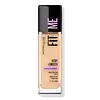Maybelline Fit Me Dewy + Smooth Foundation Versus Milani Conceal + Perfect 2-In-1 Foundation And Concealer
What's inside
What's inside
 Key Ingredients
Key Ingredients

 Benefits
Benefits

 Concerns
Concerns

 Ingredients Side-by-side
Ingredients Side-by-side

Ethylhexyl Methoxycinnamate 7%
UV AbsorberWater
Skin ConditioningCyclopentasiloxane
EmollientDimethicone
EmollientGlycerin
HumectantIsotridecyl Isononanoate
EmollientPEG-9 Polydimethylsiloxyethyl Dimethicone
EmulsifyingDisteardimonium Hectorite
StabilisingDimethicone/Polyglycerin-3 Crosspolymer
CleansingSodium Chloride
MaskingPEG-10 Dimethicone
Skin ConditioningPhenoxyethanol
PreservativeMethylparaben
PreservativeDisodium Stearoyl Glutamate
CleansingChlorphenesin
AntimicrobialDisodium EDTA
Acrylates Copolymer
Propylparaben
PreservativeParfum
MaskingTocopherol
AntioxidantAscorbyl Palmitate
AntioxidantAluminum Hydroxide
EmollientButylparaben
MaskingPEG-9
HumectantEthylparaben
PreservativeDipropylene Glycol
HumectantAlpha-Isomethyl Ionone
PerfumingTitanium Dioxide
Cosmetic ColorantIron Oxides
Ethylhexyl Methoxycinnamate 7%, Water, Cyclopentasiloxane, Dimethicone, Glycerin, Isotridecyl Isononanoate, PEG-9 Polydimethylsiloxyethyl Dimethicone, Disteardimonium Hectorite, Dimethicone/Polyglycerin-3 Crosspolymer, Sodium Chloride, PEG-10 Dimethicone, Phenoxyethanol, Methylparaben, Disodium Stearoyl Glutamate, Chlorphenesin, Disodium EDTA, Acrylates Copolymer, Propylparaben, Parfum, Tocopherol, Ascorbyl Palmitate, Aluminum Hydroxide, Butylparaben, PEG-9, Ethylparaben, Dipropylene Glycol, Alpha-Isomethyl Ionone, Titanium Dioxide, Iron Oxides
Water
Skin ConditioningCyclopentasiloxane
EmollientIsononyl Isononanoate
EmollientCetyl PEG/PPG-10/1 Dimethicone
EmulsifyingButylene Glycol
HumectantGlycerin
HumectantBis-PEG/PPG-14/14 Dimethicone
EmollientVp/Eicosene Copolymer
Ozokerite
Emulsion StabilisingPolymethylsilsesquioxane
Mica
Cosmetic ColorantDisteardimonium Hectorite
StabilisingPropylene Carbonate
SolventPhenoxyethanol
PreservativeSodium Chloride
MaskingAluminum Dimyristate
Emulsion StabilisingDisodium Stearoyl Glutamate
CleansingTriethoxycaprylylsilane
Silica
AbrasiveBis-Vinyl Dimethicone/Dimethicone Copolymer
Emulsion StabilisingIsododecane
EmollientCaprylyl Glycol
Emollient1,2-Hexanediol
Skin ConditioningC30-45 Alkyl Cetearyl Dimethicone Crosspolymer
EmollientGlycereth-18
HumectantGlycereth-18 Ethylhexanoate
Skin ConditioningBeeswax
Emulsion StabilisingPotassium Sorbate
PreservativeXanthan Gum
EmulsifyingPrunus Domestica Fruit Extract
MoisturisingC18-21 Alkane
SolventPolyisobutene
Allantoin
Skin ConditioningIron Oxides
CI 77891
Cosmetic ColorantWater, Cyclopentasiloxane, Isononyl Isononanoate, Cetyl PEG/PPG-10/1 Dimethicone, Butylene Glycol, Glycerin, Bis-PEG/PPG-14/14 Dimethicone, Vp/Eicosene Copolymer, Ozokerite, Polymethylsilsesquioxane, Mica, Disteardimonium Hectorite, Propylene Carbonate, Phenoxyethanol, Sodium Chloride, Aluminum Dimyristate, Disodium Stearoyl Glutamate, Triethoxycaprylylsilane, Silica, Bis-Vinyl Dimethicone/Dimethicone Copolymer, Isododecane, Caprylyl Glycol, 1,2-Hexanediol, C30-45 Alkyl Cetearyl Dimethicone Crosspolymer, Glycereth-18, Glycereth-18 Ethylhexanoate, Beeswax, Potassium Sorbate, Xanthan Gum, Prunus Domestica Fruit Extract, C18-21 Alkane, Polyisobutene, Allantoin, Iron Oxides, CI 77891
 Reviews
Reviews

Ingredients Explained
These ingredients are found in both products.
Ingredients higher up in an ingredient list are typically present in a larger amount.
Cyclopentasiloxane, or D5, is a silicone used to improve texture of products and trap moisture.
D5 is considered lightweight and volatile. Volatile means it evaporates quickly after application. Once evaporated, D5 leaves a thin barrier that helps keep skin hydrated.
It is also an emollient. Emollients help soften the skin and prevent water loss. Silicones create a silky texture in products. D5 helps other ingredients become more spreadable.
Studies show D5 is safe to use in skincare products. We recommend speaking with a skincare professional if you have concerns.
Learn more about CyclopentasiloxaneDSG is used as a surfactant.
Surfactants are cleansing ingredients that help remove oil, dirt, and other impurities from the skin. They work by reducing surface tension between water and oils/dirt to allow them to be easily rinsed away.
Disteardimonium Hectorite comes from the clay mineral named hectorite. It is used to add thickness to a product.
It can also help stabilize a product by helping to disperse other ingredients.
Hectorite is a rare, white clay mineral.
Learn more about Disteardimonium HectoriteGlycerin is already naturally found in your skin. It helps moisturize and protect your skin.
A study from 2016 found glycerin to be more effective as a humectant than AHAs and hyaluronic acid.
As a humectant, it helps the skin stay hydrated by pulling moisture to your skin. The low molecular weight of glycerin allows it to pull moisture into the deeper layers of your skin.
Hydrated skin improves your skin barrier; Your skin barrier helps protect against irritants and bacteria.
Glycerin has also been found to have antimicrobial and antiviral properties. Due to these properties, glycerin is often used in wound and burn treatments.
In cosmetics, glycerin is usually derived from plants such as soybean or palm. However, it can also be sourced from animals, such as tallow or animal fat.
This ingredient is organic, colorless, odorless, and non-toxic.
Glycerin is the name for this ingredient in American English. British English uses Glycerol/Glycerine.
Learn more about GlycerinPhenoxyethanol is a preservative that has germicide, antimicrobial, and aromatic properties. Studies show that phenoxyethanol can prevent microbial growth. By itself, it has a scent that is similar to that of a rose.
It's often used in formulations along with Caprylyl Glycol to preserve the shelf life of products.
Chances are, you eat sodium chloride every day. Sodium Chloride is also known as table salt.
This ingredient has many purposes in skincare: thickener, emulsifier, and exfoliator.
You'll most likely find this ingredient in cleansers where it is used to create a gel-like texture. As an emulsifier, it also prevents ingredients from separating.
There is much debate on whether this ingredient is comedogenic. The short answer - comedogenic ratings don't tell the whole story. Learn more about comegodenic ratings here.
The concensus about this ingredient causing acne seems to be divided. Research is needed to understand if this ingredient does cause acne.
Scrubs may use salt as the primary exfoliating ingredient.
Learn more about Sodium ChlorideWater. It's the most common cosmetic ingredient of all. You'll usually see it at the top of ingredient lists, meaning that it makes up the largest part of the product.
So why is it so popular? Water most often acts as a solvent - this means that it helps dissolve other ingredients into the formulation.
You'll also recognize water as that liquid we all need to stay alive. If you see this, drink a glass of water. Stay hydrated!
Learn more about WaterThis ingredient is a combination of red, black, and yellow iron oxide pigments. This combination of colors is usually found in foundation, because it results in a "skin" color.